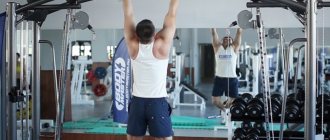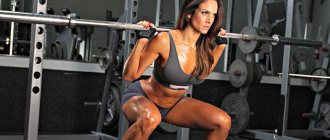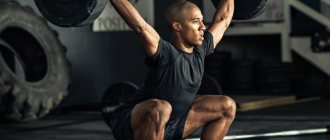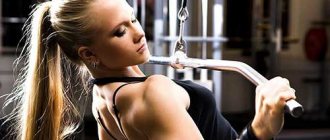Author: Timko Ilya - the ruler of the entire site and fitness trainer | more details >> Rod. 1984 Trained since 1999 Trained since 2007. Author and creator of the site tvoytrener.com. CCM in powerlifting. Champion of Russia and South Russia according to AWPC. Champion of the Krasnodar region according to IPF. 1st category in weightlifting. 2-time winner of the Krasnodar Territory championship in t/a. Author of more than 700 articles on fitness and amateur athletics. Author and co-author of 5 books.
Place in the author rating:
out of competition
(become an author) Date: 2015-08-26 Views: 367,065 Rating: 4.7
| All articles by the author >> | Medals articles >> |
Articles are loading...
| Article medals: | more than 100 comments | more than 100 thousand views |
Why medals are given to articles:
| Bronze medal: | |
| 1. The article is in the TOP 100 2. The article has more than 3. The article has more than 100 | |
| Silver medal: | |
| 1. The article is in the TOP 50 2. The article has more than 3. The article has more than 500 | |
| Gold medal: | |
| 1. The article is in the TOP 10 2. The article has more than 1 3. The article has more than 1,000 | |
Goal of the plan:
weight gain
Plan objectives:
1. Increased muscle mass.
2. Increased muscle strength. 3. Strengthening ligaments. Execution methods:
supersets | apart
Duration:
about 4 months.
Why exactly so much >>
The fact is that the body gradually gets used to the same loads. And once you get used to it, the effectiveness of the training decreases. Therefore, it makes sense to do a one-week program (consisting of one week) for 2 months (3 is maximum). Two weeks - 3-4 months. Three weeks - 4 or even 5 months. Read more here.
Difficulty – above average
This complex, as the name suggests, consists of 3 different weeks, which you simply need to alternate. After 3 weeks have passed, we start again from the first week. And so on until you get tired of it. On average, the effective duration of this plan is 4 months.
In the first week, all exercises are done separately. 2 muscle groups per workout. The second week differs from the first in that the weights are taken here more and the number of repetitions is done less. That is, the amount of work decreases, but the weights increase. In addition, there are differences in the exercises. About 1/3.
The third week is performed with supersets for one muscle group. Here the weights are the smallest, since in supersets it is basically impossible to lift maximum weights. And the intensity of training is maximum. That is, we are working on pumping, and not on strength indicators.
A superset is two exercises under one number. For example, do 1 set of barbell squats, then immediately do 1 set of leg extensions in the machine without rest. Then rest for about 2-3 minutes and repeat all over again. And so on until you have done 4 such approaches. Then move on to the next couple of exercises.
Thus, from week to week there is a constant alternation of work on mass (pumping) and work on strength (heavy weights). All this will interfere with the adaptation of your muscles to loads, and therefore contribute to the constant growth of muscle mass.
Select the exercise weight for this program
| Best result so far: | The calculator will show you what weight you need to take. But this does not include exercises on machines, but only with free weights. It is not necessary to complete all exercises. If you specify the weight for fewer repetitions, the result will be more accurate. In exercises with dumbbells, the weight of 1 dumbbell will be indicated, and with a barbell, taking into account the weight of the barbell. | ||
| Squats | kg per | once | |
| Barbell deadlift | kg per | once | |
| Bench press | kg per | once | |
| Standing chest press | kg per | once | |
| Barbell Curl | kg per | once | |
| Push-ups from the floor / from the floor from your knees | once | ||
| Dips/bench push-ups | once | ||
| Straight grip pull-ups | once | ||
Data saved
Data deleted
You did not indicate the purpose of your training
You did not indicate the purpose of your training
Delete exactly?
| YES | NO |
Gym training program
Training in the gym 3 times a week involves dividing the body into segments that combine different muscle groups. On the first day of the program, chest, biceps and leg exercises are combined. Since chest work doesn't involve your lower body, the second part of the workout allows you to work your legs.
On the second day, the muscles of the upper body are combined - triceps, shoulders and trapezius, while the chest and legs worked in the previous workout receive recovery. On the third day of the gym, it is necessary to pump up your back and abs - when working the back muscles, the biceps are also involved, but a sufficient amount of time has passed since its last workout.
// Pros of 3 workouts per week:
- develops mass and volume of the upper body
- suitable for cycle training
- great emphasis on the abs
- Convenient schedule (Mon, Wed, Fri)
// Minuses:
- reduced emphasis on leg muscles
- not suitable for ectomorphs or beginners
- implies a high level of load
- may lead to overtraining
How to do it?
How to make a workout diary at home? Everything is very simple. It is enough to have a thick notebook or notepad and pen on hand. The following should be entered in the diary:
- On the first page there are current anthropometric data.
- On the following pages, record the results of the training - exercises, approaches, repetitions and working weights. If nutrition is important, allocate space for it.
- Each page should be filled with pre-planned exercises, and during training or immediately after it, only numbers should be entered.
- On the last page (when the number of pages comes to an end) - write down new anthropometric data. Or do it periodically, for example every month.
// Day 1: chest, biceps, legs
The first day of the training program is the most difficult. It involves working the two largest muscle groups of the body - the chest and legs. Note that if you can go to the gym 4 times a week, it is better to devote a separate workout to your legs.
Pushups
An exercise to warm up and prepare the pectoral muscles for training. Vary different types and widths of hand placements, and use a footrest for added challenge. 2-3 sets of 12-15 reps
// Correct push-up technique
Chest information
The exercise is performed with an average working weight, control over the technique and a full feeling of involving the pectoral muscles in the work. Try to tighten and squeeze your chest inward as much as possible, pushing your arms forward - but without locking your elbows. 2-3 sets of 12-15 reps
Bench press
Basic exercise for the chest muscles. Can be performed both with a barbell and in a bench press machine. When performing on a horizontal bench, do not lift your legs up. Optionally, you can vary the incline of the bench every week. 3-4 sets of 7-10 reps
// Bench press - step by step technique
Barbell curls
Key exercise for developing biceps muscles. When performing, use a medium weight that allows you to perform up to 15 repetitions. Don't swing as you lift the barbell and keep your elbows at the same point. 2-3 sets of 12-15 repetitions.
// Lifting the barbell for biceps - how to do it?
Concentrated biceps curl
Always make sure you feel your biceps working. Due to the slight rotation of the dumbbell, the inner part of the biceps is included in the work - as the size increases, it pushes the main muscle upward, giving it volume. 2-3 sets of 12-15 reps
Squats
Basic exercise for the leg muscles. Can be performed both with a barbell and in a leg press machine. As you perform, keep your abs in conscious tension, lowering yourself to the point where your thighs are parallel to the floor. 3-4 sets of 7-10 repetitions.
// What do squats do and what muscles do they develop?
Leg extensions in the simulator
Exercise for targeted pumping of the anterior thigh. When doing this, also make sure that your abs remain in conscious tension. Don't help yourself lift the weight by arching your body. Can be replaced with another leg exercise. 2-3 sets of 12-15 reps
Lunges
Exercise to work the gluteus medius muscle. It can be performed both with body weight and with dumbbells. Optionally can be replaced with any other exercise for the buttocks. 2-3 sets of 12-15 reps
// The best exercises for the buttocks
Features of the program
To clearly explain all the principles of a proper training program, you would have to write a whole book - there is so much useful information that a beginner athlete needs to learn (experienced athletes do not have problems with this). However, there is a standard minimum that should be considered when developing a suitable scheme.
Of course, it is much easier to ask a coach for help. Every beginner, when visiting the gym, is “equipped” with the first standard training program. Everything would be fine, but for everyone, approximately the same plan is drawn up, which does not take into account actual physical data. Only over time does a specialist establish the real state of affairs and make adjustments to the scheme.
What to do during home exercises, because there is no trainer nearby? In this case, the athlete has to independently study the information. In order to compose the program as competently as possible, be sure to take into account the following points.
// Day 2: Shoulders, triceps, traps
The second day of the training program focuses on the upper half of the body. The goal is to work out the muscles that give the figure massiveness. Round and voluminous shoulders will make the figure wider, and large triceps will increase the volume of the arms, visually expanding the biceps.
Reverse push-ups on a bench
An exercise to warm up the upper body and prepare joints for work. It can be performed both from the ground and on two benches - push-ups on uneven bars are also acceptable. At the top, try to push your body weight as high as possible. 2-3 sets of 12-15 repetitions.
// Reverse triceps push-ups - step by step
Dumbbell lateral raises
Exercise for the middle part of the deltoid muscles. When performing, use medium weight dumbbells and control the stationary position of the body. The back should be straight, the arms should not bend at the elbows. Raise the weight to horizontal. 2-3 sets of 12-15 reps
Front dumbbell raises
Exercise for the front of the deltoid muscles. Also use medium weight dumbbells and watch your form. Start raising your arm only when the opposite arm is at the bottom of the movement. 2-3 sets of 12-15 reps
Seated dumbbell press
Basic exercise for the shoulder muscles. It can be performed either with dumbbells (both sitting on a bench and standing) or with a barbell - standing barbell press. When performing, keep your abs in conscious tension; when lifting the weight up, do not push it out using the strength of your core - only your shoulders work. 3-4 sets of 7-10 reps
Reverse triceps extensions
An exercise for the middle head of the triceps that gives volume to the muscle. It can be performed either with dumbbells on a bench or in a machine with a rope (the body is strictly perpendicular to the floor). Make slow movements, tensing your triceps even more at the final point of the movement. 2-3 sets of 12-15 reps
Overhead triceps press
A key exercise for developing triceps. Can be performed either sitting on a bench or lying on a bench (with an EZ bar). The elbows should be parallel to each other and should not move to the side when moving the weight. Can be replaced with another triceps exercise. 3-4 sets of 7-10 reps
// How to properly pump your triceps?
Lateral dumbbell raises
Exercise to work the trapezius and middle deltoid muscles. When lifting dumbbells, the elbows are slightly bent, moving in a semicircle. Make sure that your lower back does not arch. 3-4 sets of 7-10 reps
Lifting dumbbells to the chin
Exercise for trapezius and deltoid muscles. Gives the shoulders a characteristic rounded shape. When lifting up, make sure not to lift the dumbbells too high - strictly to the parallel line. Perform the exercise slowly, engaging as many muscle fibers as possible. 2-3 sets of 12-15 reps
How to make a sports plan for beginners
When creating a program, you need to decide on the main goals of the workout (gaining muscle mass or losing weight).
You need to have a good understanding of the physical capabilities of your body. Too much stress will do more harm than good. The regularity of training is also important. 60% of success depends on this factor.
Important! A competent program, including all stages: from warming up to stretching, will allow the muscles not only to pump up, but also have time to recover.
The best choice for a beginner is a base and working with free weights. You can also include one of the elements of plyometrics into the schedule, which strengthens the heart muscle.
How much to study: choosing a suitable scheme
It's simple: beginners train 3-4 times, professionals – 2-3. This is due to the nature of the athletes’ loads.
Experienced athletes work with extremely heavy weights aimed at increasing strength, so it takes more time to restore muscle tissue.
The task of beginning athletes is to prepare the body for such a load, so the main work is aimed at increasing muscle elasticity, joint mobility, increasing endurance and developing the technique of performing elements.
// Day 3: back and abs
The final day of training is based on working the back and abs. Lat rows and pull-ups develop the latissimus dorsi, while dumbbell rows and seated rows add thickness. Optionally, the training program may include deadlifts.
Pull-ups
Exercise to warm up the latissimus dorsi muscles. When performing, keep your abs in conscious tension, and at the top point, feel the work of your back muscles, pushing your body weight higher. Don't swing. 2-3 sets of 12-15 repetitions.
// How to learn to do pull-ups?
Upper block pull
By using additional weight, it allows you to perform a movement similar to a pull-up - but with more impact. Using different handles and grips allows you to modify the exercise and use different back muscles. 3-4 sets of 7-10 reps
// Lat Pulldown - Correct Technique
Dumbbell row to waist
Exercise to make your back muscles thicker. The goal is to engage the lats, not just lift as much dumbbell weight as possible using your arm muscles. Make sure your spine is straight and not arched (especially upwards). 3-4 sets of 7-10 repetitions.
Lower block thrust
If there is an opportunity in the gym to perform a full deadlift with a barbell, do the deadlift. Otherwise, the exercise can be replaced by pulling the lower block to the belt. 3-4 sets of 7-10 repetitions.
Bicycle press
Exercise to work the oblique abdominal muscles. It involves bending the leg at the knee and bringing the opposite elbow towards it. It is performed with a tense press and with a full feeling of involving the abdominal muscles in the work. 3-4 sets of 10-15 repetitions.
// Exercise “Bicycle” - what is the benefit?
Bench crunches
Exercises to develop the rectus abdominis muscles. When lifting up, do not hold your breath and make sure that the load does not transfer to the lower back and lower back. At the top point, tighten your abs even more. 3-4 sets of 10-15 repetitions.
Plank
The most important static abdominal exercise that develops the internal and transverse abdominal muscles. The plank is performed in a static mode - it is necessary not to repeat the movement, but to hold still. Alternate between different types (on the elbows, on outstretched arms, side). 3-4 sets of 60-90 seconds.
Hyperextension
Exercise to strengthen the lower back and lower back. It can be performed both dynamically and statically. As you rise up, be careful not to go too high, arching your spine back. 2-3 sets of 10-15 reps
// Hyperextension - technique and types
Pros and cons
Despite the undeniable advantages of keeping a training diary, there are a huge number of opponents to using this method. They generally consider it useless and sometimes harmful. Let's look at the advantages and disadvantages:
| Behind | Against | Solution |
| Systematizes the approach to training. | Limits the use of “intuitive training” | Fill out the data after training, indicating the number of repetitions, and not before the lesson. |
| Indirectly allows you to avoid overtraining. | Limits progress to the data in the diary, and not to the maximum load that the athlete expects. | In this case, it is better to combine sensations and not plan the workout in advance; the diary should only reflect the work already done. |
| Allows you to control the results. | It's easy to fool yourself by recording smaller or larger results. | You can deceive yourself without a training diary. By conducting it systematically, this factor is leveled out over time. |
| Allows you to determine the progression of loads. | Not suitable for constantly changing programs. | It is enough to group loads or records, which allows you to evaluate the improvement of results when repeating a similar complex in the future. |
| Allows you to determine which loads the body responds to best. | Does not allow you to describe the sensations and well-being after certain types of training. | Discipline and falsification of results are a matter of self-awareness of the athlete and do not relate to keeping a diary. Feelings and well-being can be recorded in the form of comments. |
| Allows you to create a “discipline” factor. | Allows you to fake results. | |
| Allows you to check and analyze progress over the long term. | Easily lost. Additional discipline is required to conduct honestly and consistently. |
As can be seen from all of the above, you need to understand how to design a training diary, and then, even in the conditions of “intuitive training,” it will allow you to achieve better results and systematize your approach to strength sports.
Workout plan
A weight training program necessarily involves a preliminary warm-up. Spend the first 5-10 minutes of the gym doing light cardio, then move on to preparing your joints. Warming up the joints is especially important for those who have suffered a sports injury.
Both a treadmill or rowing machine, as well as jumping rope, are suitable for warming up. The main rule is to increase your heart rate to 150 beats - just sweat a little. Then - light preparation of the joints (rotations with arms extended to the sides, squats with arms extended forward).
// How to properly train:
- warm-up (treadmill, exercise bike) - 5-10 minutes
- strength training in the gym - 60 minutes
- cool down and stretching (posture exercises) – 10 minutes
- cold or contrast shower
General information
First you need to decide what it is. Despite common misconceptions, this is not some kind of mythical shopping diary, but simply a technique for systematizing classes.
The training diary itself is a means of recording the results of the exercises. Usually they write in it:
- Training date.
- Exercises included in the workout.
- Number of repetitions and approaches.
- Working weights.
- Rest time between sets (not always, only if it is important).
- Anthropometry (not always, but it is useful to do this periodically to track progress).
- Additional notes and comments.
- Meals, their composition (BJU) and calorie content (not always, but will be useful when gaining weight and cutting).
The combination of these factors makes it possible to determine the further vector of development; in addition, the training diary is useful in the event of a change of trainer/gym. In particular, it allows a new trainer to determine the dynamics of your development and more accurately select a new training program in accordance with your progress.











